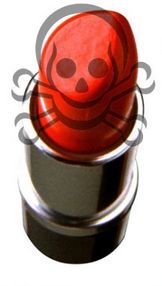
© Campaign for Safe Cosmetics
It took nearly two years, but FDA has finally published its study on lead in lipstick, and the findings are not reassuring. FDA found up to four times more lead in lipstick than previous reports.
Even less reassuring is the fact that FDA spent two years studying the problem, only to discover that, yup, there really is lead in lipstick - and then decide that, no, they're not going to do anything about it.
Wasn't FDA once the world's gold standard agency for consumer protection? Don't they exist for the purpose of ensuring that America has the safest possible food, drugs and cosmetics?
If so, one might expect FDA to work with companies to ensure they are making the safest possible lipstick with the lowest levels of lead.
Instead, FDA put up a web page dismissing health concerns about leaded lipstick because "lipstick is a product intended for topical use, is only ingested incidentally and in very small quantities."
This statement is not based on science. There are no studies we can find that look at how much lipstick gets into the body. Such studies are not required of industry, and have not been conducted by FDA.
If we're going to engage in speculation, we may as well ask: Hey FDA, if lipstick doesn't end up in our bodies, where does it go? And why does it need to be reapplied so frequently? Because the lips are one of the most sensitive and absorbent body parts; plus, as anyone who has used it knows, lipstick gets onto our teeth, our food and into our mouths.
Further reducing the credibility of their web page, FDA based their "safety" conclusions not on their own study, but on a draft recommendation from Canada and a ruling from California's Proposition 65 law that
doesn't even consider the science on neurotoxicity.
The fact is, any level of lead in lipstick is a concern, because even the smallest amount of lead can harm developing brains. In a review of recent science, Harvard Medical School researcher David Bellinger, PhD, concluded:
"No level of lead exposure appears to be 'safe' and even the current 'low' levels of exposure in children are associated with neurodevelopmental deficits."If we want to protect children from lead exposure, we need to protect pregnant women from lead exposure - as well as women who may be pregnant or who may someday want to become pregnant, because lead builds up in the body over time and stays with us.
In other words, we need to protect all women from unnecessary lead exposures by getting the lead out of lipstick.
An interesting finding of the FDA study is that lipsticks made by three manufacturers had consistently higher lead levels. The most contaminated brand, made by Manufacturer A, had 11 times more lead than the average level found in the bottom 10 brands. Who is Manufacturer A? FDA won't name the brands.
We did name brands in the 2007 study conducted by the Campaign for Safe Cosmetics , which also found that a few brands had consistently higher lead levels. Those were L'Oreal, Maybelline NY (made by L'Oreal) and Cover Girl.
These companies can do better, and they must be held accountable to make the safest products possible. The appropriate action for FDA is to do what a group of U.S. Senators asked them to do two years ago: set a maximum level of lead in lipstick that corresponds with the lowest lead levels found in laboratory tests.
FDA took a similar step to protect children from lead in candy, by setting a maximum lead level of .1 ppm. This level was not chosen because .1 ppm of lead is safe in candy, it was based on the reasoning that .1 ppm is the lowest lead level candy manufacturers can achieve. Using its own logic, FDA should set a similar standard for lead in lipstick.
Help us give the beauty industry a makeover by joining the Campaign for Safe Cosmetics action list and sign our petition to give the FDA a makeover too.
Additional Information from the Campaign for Safe Cosmetics Important facts about lead in lipstick:
* 61% of brand-name lipsticks recently tested contain lead
* the average American woman consumes (ingests) 4 lbs of lipstick over the course of her lifetime
* The US FDA (Food and Drug Administration) does not regulate the level of lead in lipstick
* Many lead-containing lipsticks have more lead in them than is allowable in candy
* It is almost impossible for the human body to dispose of or break down lead. It accumulate in body tissues over time, so even a small amount, over time, can pose health risks
* Lead is a neurotoxin - it damages brain and nerve cells
* Lead poses a particular risk to pregnant women, since it can cross the placenta into the fetus and cause developmental problems
Reader Comments
to our Newsletter